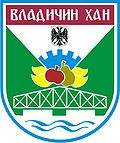Top Qs
Timeline
Chat
Perspective
Vladičin Han
Town and municipality in Southern and Eastern Serbia, Serbia From Wikipedia, the free encyclopedia
Remove ads
Vladičin Han (Serbian Cyrillic: Владичин Хан, pronounced [ʋlǎdit͡ʃiŋ xâːn])[a] is a town and municipality located in the Pčinja District in southern Serbia. The town is located along the road from the Serbian capital Belgrade to the Greek city of Thessalonica. It is located close to the Serbian border with Bulgaria and North Macedonia. As of 2022, the population of the town was 7,343, while the population of the municipality is 17,532.
Remove ads
History
In the 17th century, a house ("Han") was built by Stefan Grk, which was later bought by Bishop Pajsije of Janjevo. A small settlement was established in 1887 around the house, and was given the name of Vladicin Han. In 1888, the first school was established, and a temple of Saint Nikola was built in 1905. In 1910, an iron bridge was built to replace the old wooden bridges. With the development of railways, it became an established town in the 1920s with flourishing trade and economy.[3]
Remove ads
Geography
The town is located in the Pčinja District in southern Serbia, about 60 km (37 mi) from the Serbian border with Bulgaria and North Macedonia. It is along the road connecting the Serbian capital Belgrade to the Greek city of Thessalonica.[4] The town lies at the mouth of two rivers–Vrla and Kalimanka, which flows into the South Morava.[3] The Vlasina Mountain and Lake are located close to the town.[5]
Settlements
Aside from the town of Vladičin Han, the municipality includes the following settlements:[6]
- Balinovce
- Bačvište
- Belanovce
- Beliševo
- Bogoševo
- Brestovo
- Dekutince
- Donje Jabukovo
- Dupljane
- Džep
- Garinje
- Gornje Jabukovo
- Gramađe
- Jagnjilo
- Jastrebac
- Jovac
- Kalimance
- Kacapun
- Koznica
- Kopitarce
- Kostomlatica
- Kržince
- Kukavica
- Kunovo
- Lebet
- Lepenica
- Letovište
- Ljutež
- Mazarać
- Manajle
- Manjak
- Mrtvica
- Ostrovica
- Polom
- Prekodolce
- Priboj
- Ravna Reka
- Rdovo
- Repince
- Repište
- Ružić
- Solačka Sena
- Srneći Dol
- Stubal
- Suva Morava
- Tegovište
- Urvič
- Vrbovo
- Zebince
- Žitorađe
Remove ads
Economy
Summarize
Perspective

The first factory that was established in the town was a brick factory, which is still operational. With the development of transport connectivity, the town saw an influx of people in the early half of the 20th century. Though agriculture was feasible in and around the areas surrounding the town, more people were engaged in manufacturing and trading due to its higher profitability. Trade fairs are common, with the largest fair taking place in September every year. The original market, which was established more than a hundred years ago on the river bed of Kalimaka, still functions as the main market place. Agricultural produce include dairy, fruits, potato, and corn. Between the 1920s and the 1940s, the town was a major center of tobacco production. The town was also popular for its crafts and indigenous works, with a craftsman center functioning since the late 19th century.[3]
As per the data from the Serbian government, the following table gives a preview of the total number of registered people employed in legal entities per their core activity in 2018:[7]
Demographics
According to the 2022 census results, the population of the town was 7,343, while the population of the municipality is 17,532.[2] As of 2011, Serbs formed the majority in the municipality with Romani making up a significant minority.[9]
Remove ads
See also
Notes
- Vladičin / Владичин pronounced in isolation: [ʋlǎdit͡ʃin]
References
External links
Wikiwand - on
Seamless Wikipedia browsing. On steroids.
Remove ads






